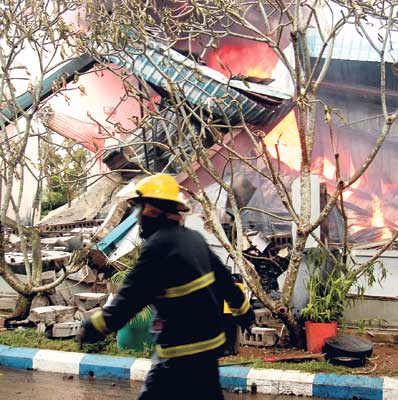
Fire and Business – Taming the deadly flamesLet us - for a moment - walk down memory lane to 1996. The last day in the month of January displayed the brutality of urban terrorism for the umpteenth time. It was the devastating bomb explosion at the Central Bank – CBSL - entrance. If the explosion was terrifying enough, the worst was the flashing fireball that followed the explosion and wrapped around many other clustered business locations.
The trapped employees and business associates were helplessly screaming up in high rise buildings amidst thick smoke, frightening heat and nerve wracking uncertainty–It was a heart-rending sight. The roaring flames were blowing upward - floor by floor - and people had only single path to get away. It was a fear-filled skyward climb, praying to all gods – looking for rescue before the lethal flames from the bottom would engulf them to painful death in slow motion. Many survived eventually. Some were not so fortunate. Among them were two Srilankan Airlines girls whose bodies were traced later – burned to death inside their office. On that fateful morning, they came to work - like many of us do, but never got back home. The recent automobile collision at Induruwa – a passenger bus and a beer container truck (both on business tours) resulted in the horrible fate of being - BURNED ALIVE - for many of the commuters. The released visuals of that tragedy - circulated via eMail had a preview warning “If you are weak hearted, do not open the attached visuals.” The visuals of burned-to-death bodies were far too horrific for many of us to bear. Those innocent passengers only got in to the bus, but never got off. Imagine the result, if you were trapped in that ill - fated bus. A blue chip conglomerate in Sri Lanka recently experienced three consecutive fires in a short span of time that totally destroyed their production from four factories. Fortunately, there was no loss of life reported, as the fires occurred at a time when human presence was at a minimum. While the direct impact is from destruction caused by fire – indirectly - the cost of replacement, loss of employment, loss of current market domination, competitor advantage, share value depreciation and loss of immediate business opportunities may have been calculated as an enormous business deficit. The Phoenix may have flapped out of the ashes, but it is not that easy for a business to recover. Corporate fires are too expensive. It is costly at the outset due to the life risk of business associates, service partners, customers and visitors. The fire crisis in a business locality creates a psychological wound embedded in the mind of business associates who experienced it - for very many years to come. It has a hidden emotional connectivity to their level of performance and operating confidence. The sense of fire safety supports positive business energy and - the absence of it surely thrusts towards negative energy cycle. Adding more spice to the risk - greater the business complexity, the challenge of protecting all forms of data – be it hard or soft – also becomes a challenge that demands specialized fire protection solutions, designed on corporate perspective. Although the risk of fire is a business reality, only some businesses are prepared professionally to mitigate the resultant damage to their business in terms of life, asset and data protection. Others may opt to pick the path of least consideration which could aptly be termed as spontaneous corporate negativity and “hope for the best syndrome”-as a measure of convenience. Yet, it is too much of a risk to rely - upon the “luck” factor which has little or nothing to do with professional competence and responsibility of the management to its stakeholders. Two schools of thought govern this indifferent thinking. The lead thought is that the company is covered by a comprehensive fire insurance safety net. It in fact is a pro- active business move in support of risk transfer management. The missed point here is how a business or insurance compensation could physically replace a lost mother to her infant. Or a burnt face that once was beautiful. The other perception in here is that the Fire Brigade is just a call away and there is nothing to worry about in a fire scenario. While the FB facility is a colossal strength in mitigating corporate fire damage, due to our road constrains, the immediate response principally rests on situational traffic freezes - that in certain cases are miles long – yet stand still. If our employees are exposed to potential (but undercurrent) danger of getting trapped within – facing the threat of being burnt alive in the event of a fire rampage and - yet still (unconcerned) we opt to travel a great distance to execute our Corporate Social Responsibility – CSR – initiatives elsewhere, it raises more embarrassing questions than pleasing answers about our leadership sincerity. As a saying enlightens us “The impact of a deadly fire can only be determined by what is no longer standing tall”. The inconvenient truth is that it could be your best employee or the pinnacle of your lifetime business efforts that is no longer standing upright. That endorses the gravity of fires and the need for professional corporate fire safety management in business. The author is Strategic Security Specialist / Pragmatic Trainer & CEO of Strategic Security Solutions. He can be reached at – solutions@sltnet.lk |
|
||
| || Front
Page | News
| Editorial
| Columns
| Sports
| Plus
| Financial
Times | International
| Mirror
| TV
Times | Funday Times|| |
| |
Copyright
2007 Wijeya
Newspapers Ltd.Colombo. Sri Lanka. |
